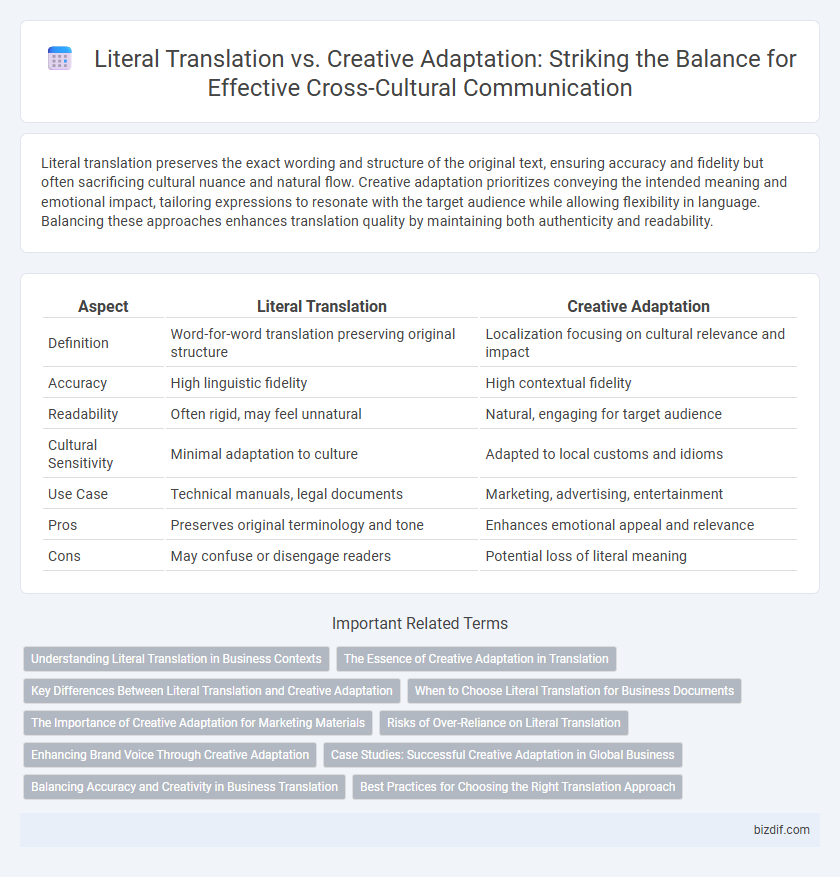Literal translation preserves the exact wording and structure of the original text, ensuring accuracy and fidelity but often sacrificing cultural nuance and natural flow. Creative adaptation prioritizes conveying the intended meaning and emotional impact, tailoring expressions to resonate with the target audience while allowing flexibility in language. Balancing these approaches enhances translation quality by maintaining both authenticity and readability.
Table of Comparison
| Aspect | Literal Translation | Creative Adaptation |
|---|---|---|
| Definition | Word-for-word translation preserving original structure | Localization focusing on cultural relevance and impact |
| Accuracy | High linguistic fidelity | High contextual fidelity |
| Readability | Often rigid, may feel unnatural | Natural, engaging for target audience |
| Cultural Sensitivity | Minimal adaptation to culture | Adapted to local customs and idioms |
| Use Case | Technical manuals, legal documents | Marketing, advertising, entertainment |
| Pros | Preserves original terminology and tone | Enhances emotional appeal and relevance |
| Cons | May confuse or disengage readers | Potential loss of literal meaning |
Understanding Literal Translation in Business Contexts
Literal translation in business contexts involves converting text word-for-word to preserve the original meaning, ensuring accuracy in legal contracts, technical manuals, and financial reports. This approach minimizes misinterpretation and maintains compliance with regulatory standards across international markets. However, it may limit the expression of cultural nuances essential for marketing and customer engagement strategies.
The Essence of Creative Adaptation in Translation
Creative adaptation in translation captures the cultural nuances and emotional tone of the source text, ensuring the message resonates authentically with the target audience. Unlike literal translation, it balances fidelity to the original meaning with localized expressions and idiomatic relevance. This approach enhances engagement by preserving the intent and spirit behind the words rather than strictly adhering to word-for-word accuracy.
Key Differences Between Literal Translation and Creative Adaptation
Literal translation closely adheres to the source text's exact wording and structure, preserving its original meaning but often lacking natural flow in the target language. Creative adaptation prioritizes cultural nuances, idiomatic expressions, and audience relevance, allowing significant modification to convey the intended message effectively. The key difference lies in literal translation's emphasis on accuracy versus creative adaptation's focus on contextual resonance and readability.
When to Choose Literal Translation for Business Documents
Literal translation is essential for business documents when accuracy and clarity of technical terms, legal clauses, or financial data must be preserved to avoid misinterpretation or legal risks. Maintaining the original meaning without alteration ensures compliance with regulatory requirements and facilitates clear communication between international partners. Choosing literal translation supports consistency in brand messaging and contractual obligations across different languages and markets.
The Importance of Creative Adaptation for Marketing Materials
Creative adaptation in marketing translations enhances cultural relevance and emotional resonance, driving higher engagement and brand loyalty. Literal translation often fails to capture idiomatic expressions, humor, or local nuances, leading to misinterpretation or lackluster responses. Tailoring messages through creative adaptation ensures that marketing materials effectively connect with target audiences, maximizing impact and conversion rates.
Risks of Over-Reliance on Literal Translation
Over-reliance on literal translation can result in loss of cultural nuance and idiomatic expressions, leading to misinterpretation and reduced message impact. It often fails to convey the original tone, style, and intent, making the content less engaging or even confusing for the target audience. Such rigid translation limits the adaptability required for effective localization, ultimately compromising communication quality.
Enhancing Brand Voice Through Creative Adaptation
Creative adaptation enhances brand voice by transforming content to resonate emotionally and culturally with target audiences, ensuring messaging remains authentic and impactful across languages. Unlike literal translation, which prioritizes word-for-word accuracy, creative adaptation captures the brand's tone, style, and personality, fostering stronger customer engagement and loyalty. This approach leverages cultural nuances and idiomatic expressions to create a memorable brand experience that aligns with local market expectations.
Case Studies: Successful Creative Adaptation in Global Business
Successful creative adaptation in global business often involves tailoring marketing messages to resonate culturally with target audiences, as demonstrated by Coca-Cola's varied advertising strategies across different countries. Case studies reveal that companies like Nike achieve higher engagement by adapting slogans and campaigns creatively rather than relying on literal translations, ensuring contextual relevance and emotional impact. These examples underscore the strategic importance of creative adaptation in enhancing brand recognition and customer loyalty in diverse international markets.
Balancing Accuracy and Creativity in Business Translation
Balancing accuracy and creativity in business translation requires a nuanced approach between literal translation and creative adaptation. Literal translation ensures precise terminology and maintains legal or technical integrity, essential for contracts, manuals, and regulatory documents. Creative adaptation enhances cultural relevance and brand messaging, improving engagement and resonance with the target audience in marketing materials and corporate communications.
Best Practices for Choosing the Right Translation Approach
Selecting the right translation approach depends on the target audience and the purpose of the content. Literal translation ensures accuracy and preserves the original meaning, making it suitable for technical documents and legal texts, whereas creative adaptation enhances cultural relevance and emotional impact, ideal for marketing materials and literary works. Evaluating context, cultural nuances, and desired engagement level guides translators toward the most effective method between literal fidelity and creative flexibility.
Literal Translation vs Creative Adaptation Infographic

 bizdif.com
bizdif.com